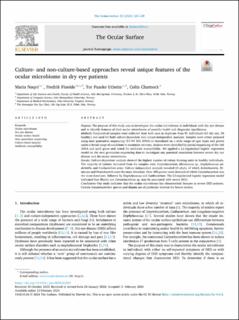Culture- and non-culture-based approaches reveal unique features of the ocular microbiome in dry eye patients
Peer reviewed, Journal article
Published version

View/
Date
2024Metadata
Show full item recordCollections
Original version
https://doi.org/10.1016/j.jtos.2024.02.002Abstract
Purpose: The purpose of this study was to investigate the ocular microbiome in individuals with dry eye disease and to identify features of their ocular microbiome of possible health and diagnostic significance. Methods: Conjunctival samples were collected from both eyes in duplicate from 91 individuals (61 dry eye, 30 healthy) and used for both culture-dependent and culture-independent analyses. Samples were either analysed using next generation sequencing (V3-V4 16S rDNA) or inoculated on a wide range of agar types and grown under a broad range of conditions to maximize recovery. Isolates were identified by partial sequencing of the 16S rDNA and rpoB genes and tested for antibiotic susceptibility. We applied a L2-regularized logistic regression model on the next generation sequencing data to investigate any potential association between severe dry eye disease and the ocular microbiome. Results: Culture-dependent analysis showed the highest number of colony forming units in healthy individuals. The majority of isolates recovered from the samples were Corynebacterium, Micrococcus sp., Staphylococcus epidermidis, and Cutibacterium acnes. Culture independent analysis revealed 24 phyla, of which Actinobacteria, Firmicutes and Proteobacteria were the most abundant. Over 405 genera were detected of which Corynebacterium was the most dominant, followed by Staphylococcus and Cutibacterium. The L2-regularized logistic regression model indicated that Blautia and Corynebacterium sp. may be associated with severe DED. Conclusions: Our study indicates that the ocular microbiome has characteristic features in severe DED patients. Certain Corynebacterium species and Blautia are of particular interest for future studies.
